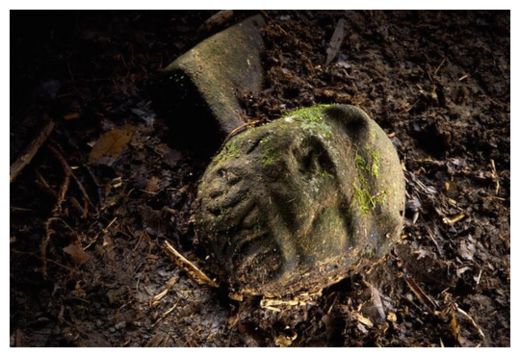
As first reported by National Geographic on Monday, Christopher Fisher, an archaeologist from Colorado State University, and his colleagues traveled to the site based on long-standing rumors that it was the location of a city referred to in legend as the "City of the Monkey God."
Cult of the Were-Jaguar?
The city, which belonged to a culture so mysterious that experts have not even found a name for it, was extensively mapped by Fisher's team, who found plazas, earthworks, mounds and even an earthen pyramid at the site, according to the website. The expedition, which lasted through last Wednesday, also uncovered a collection of stone sculptures and dozens of artifacts.
In the article, Fisher called the find "incredibly rare," especially since it was in perfect condition and had not been targeted by looters. He went on to speculate that the statues, which were found at the base of the pyramid, were "a powerful ritual display" and most likely an offering.
Among the more than 50 artifacts found there included ceremonial seats known as metates and carved vessels that had been decorated with snakes, vultures and other figures. One of the finds was the head of what the archaeologists believe was a "were-jaguar" sticking out of the ground. It is believed to be depicting a shaman in a transformed-spirit like shape, National Geographic said.
The research team believes that many more artifacts have been buried underground at potential burial sites, and many of the objects discovered were catalogued but not excavated. The lost city was first identified during an aerial survey of the La Mosquitia region in 2012, the report noted, and in order to protect the ruins from looters, their exact location is not being disclosed.
Tales of the White City
However, the story of this place, which is also known as Ciudad Blanca or the White City, dates back several hundred years. As Nat Geo explains, explorers and prospectors often told tales of a lost city with white ramparts visible above the jungle canopy, and local stories have mentioned a mystical paradise or "white house" where Indians went to escape Spanish conquistadors.
Several expeditions have sought out the location of this White City, some dating as far back as the 1920s, according to the website - including a 1940 expedition in which Theodore Morde of the Museum of the American Indian claimed to have found it and brought back artifacts from the city. He refused to reveal its location, however, and died without his claims being verified.
Fast forward to 2012
In 2012, a pair of documentary filmmakers named Steve Elkins and Bill Benenson launched a search for the lost city, and used a lidar (light detection and ranging) scanned from the Center for Airborne Laser Mapping at the University of Houston to aid their search.
Once Fisher analyzed the processed lidar images, he reportedly discovered "evidence of public and ceremonial architecture, giant earthworks and house mounds, possible irrigation canals and reservoirs" indicative of the presence of a pre-Columbian city, Nat Geo explained.
Fisher later confirmed the discovery as part of an expedition that also involved an anthropologist, an ethnobotanist, documentary filmmakers, a lidar engineer, a writer and photographer from the National Geographic Society and a security detail made up of Honduran Special Forces soldiers, but instead of one lost city, they believe they may have stumbled upon an entire lost civilization.



or it didn't happen...